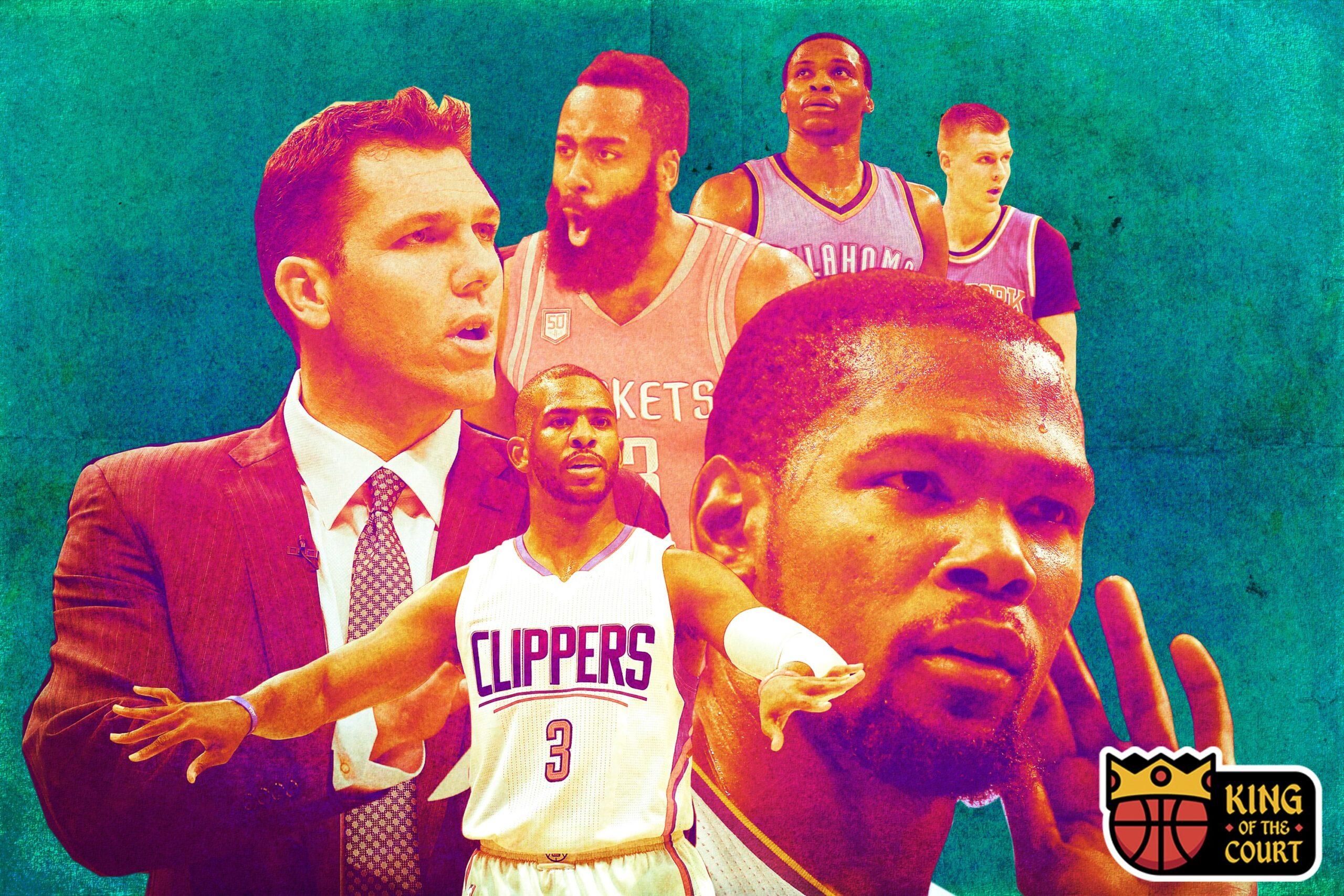
We’ve been celebrating the best performances of the NBA season daily here at The Ringer. With Thanksgiving conveniently reminding us that we’re officially a month into the action, this feels like as good a time as any to take stock in the players (and coach) whose early brilliance have established the narrative and trajectory of the season. Here are our Kings of the Court so far.
Kevin Durant, Golden State Warriors
Kevin O’Connor: In 1969, Neil Young joined the established supergroup Crosby, Stills & Nash to form CSNY. They made unforgettable music together, but Young didn’t necessarily become a better singer, songwriter, or guitarist. When Kevin Durant signed with the Warriors to form Curry, Thompson, Green & Durant, the team’s collective potential skyrocketed, but it was uncertain how much better, if at all, Durant would be individually.
The answer so far is WAY BETTER. Durant is posting his lowest usage rate (28.1 percent) since his rookie season, but he’s still averaging 26.9 points, 8.2 rebounds, and 4.5 assists per game — numbers either in line with or better than his career averages. Playing off his superstar teammates has increased his efficiency astronomically. No matter how the Warriors use Durant on offense (transition, pick-and-roll, isolation, spot-ups, cuts, or screens), he grades as one of the league’s most effective scorers. Over the last five seasons, Durant posted a dominant 56.1 effective field goal percentage (eFG); now, with Golden State, his eFG has risen to 62.4 percent, which is bordering on historic. No player has ever finished a season attempting more than 15 shots per game with an eFG higher than 63.0 percent, per Basketball-Reference. If Durant even only slightly improves upon his early clip, he could beat the record held by (who else?) his bandmate, Stephen Curry.
One of the most efficient scorers in league history is scoring more efficiently than ever before, and it’s getting pretty easy to see why he joined the Warriors. There’s still a distinct chance it will all get better; this supergroup is still working on its rhythm. The release date for their album Déjà Vu is still set for mid-to-late June.
Chris Paul, Los Angeles Clippers
Jonathan Tjarks: Chris Paul exists outside of time. This is his sixth season with the Clippers, and his 12th in the NBA, yet he shows no signs of slowing down or having to adjust his game for age. He started his career as one of the fastest players in the NBA, but he learned long ago that a car taking the most direct route at 65 miles per hour is going to beat the one impatiently cutting through traffic and taking off-ramps and access roads. There are no wasted movements or rough edges for Paul. He’s a basketball-playing machine who has been optimized to always make the most efficient play on both sides of the ball.
The Clippers have the best bench of the Lob City era this season, but their core starting lineup is the same as ever, with Paul orchestrating the action from the top of the key, running pick-and-rolls with Blake Griffin and DeAndre Jordan, and finding J.J. Redick as he comes off screens. So many years of playing together has given them a mind-meld that allows them to move on a string, relentlessly prodding the defense until the weak spot reveals itself and the ball finds its way to the exact spot it needs to be. With Paul at the controls, the Clippers can play the game on autopilot.
While the rest of the league is figuring out rotations and what their identity is on both ends of the floor, the Clippers are doing what they have always done, except better. If there’s a discernible difference for Paul this season, it’s his 3-point shooting. He is taking a career-high number of attempts from behind the arc (five a game) at a career-high 43.6 shooting percentage. Maybe it’s his offseason Lasik surgery, or maybe it’s an early-season hot streak that will fade with time, but spending more time at the 3-point line does offer a path for Paul to continue fighting off Father Time. The less time he spends trying to get into the paint, the less wear and tear he’ll put on his body. Slightly redistributing where he takes his shots can make him a more efficient player without changing anything else about his game.
Of course, nothing really matters for Paul until the postseason, where he has to confront demons that have plagued him his entire career. Ever since he came to Los Angeles, the Clippers have found new and inventive ways to collapse in the playoffs, with losses to the Spurs, Grizzlies, Thunder, Rockets, and Blazers on their résumé. With the exception of Portland, who had the benefit of playing an injury-ravaged team without Paul or Griffin when they beat Los Angeles, all those teams have changed dramatically since the last time they knocked off the Clippers. The Clippers, meanwhile, have kept plugging away, methodically improving on the margins and waiting for their chance to break through. Paul came into the league as an undersized speed demon, so it was easy to see him as the hare, but maybe he was the tortoise all along.
James Harden, Houston Rockets

Chris Ryan: What an adorable year for having our preconceived notions of how things work be challenged (I guess). I still can’t believe Daryl Morey’s “more cowbell” philosophy is working here. When faced with the question of how to get a team led by James Harden to the next level, Morey’s response was to let James Harden be the most James Harden he could possibly be. So: hire Mike D’Antoni to coach the team, turn Harden into Steve Nash and Joe Johnson at the same time, using Clint Capela as a human shield, and run a screwed and chopped seven-beards-or-less offense that seems impervious to the opponent’s defensive scheme.
The numbers so far are obscene: four games with at least 30 points and 15 assists (that happened only three times last season … LEAGUEWIDE), leading the league in assists per game, and fourth in points per game. He is responsible for 53.9 percent of Houston’s points. Mike and Daryl gave him the keys to the car, and he turned the car into a spaceship.
The last few seasons of Harden in Houston felt somehow disingenuous, like he had hacked basketball — all flops, foul shots, and head feints. He was bending the game to his preferences. This season, Harden broke the game, and it is glorious.
Russell Westbrook, Oklahoma City Thunder
Danny Chau: Would it be easier on the psyche if we categorized Westbrook’s season as an art installation? Exploring the Limits of Control, maybe. What happens when a player bypasses the system unto himself trope and becomes a franchise’s life support?
After years of pushing back against the idea that he could never be a true point guard, Westbrook has broken through completely. Where he used to leverage his body like a sledgehammer shot out of a cannon, these days he doesn’t have to. He operates in bullet time. Distinct angles and openings are created by sheer force of Westbrook’s physical presence; opponents have to account for him differently than any other player in the league. For a while, Westbrook treated broken plays like one would a malfunctioning monitor or a janky remote control — he smacked them into compliance. What’s changed now is how in tune he is with the way plays take shape, and how quickly he can exploit a gap in space to assist a teammate.
Fifteen games in, Westbrook is as close as humanly possible to averaging a triple-double without actually averaging a triple-double; he is first in the league in points (31.8) and second in assists (10.6) per game — behind only James Harden, another system-unto-himself positional anomaly — and ninth in the NBA in total rebounds (143) while being at least 7 inches shorter than everyone above him on the leaderboard.
Is it stat padding when having the ball in Westbrook’s hands is the lifeblood of any and every successful Thunder offensive possession? When Westbrook is on the floor, Oklahoma City produces points at an above-average rate; in the quarter’s worth of action he sits on the bench, the Thunder’s offensive efficiency plummets to levels we haven’t seen since the immediate post-Jordan Bulls of 1999 and 2000 — the NBA’s own Great Depression. The league has started tracking “potential assists,” which count not only the passes that led to field goals, but also the passes that would have led to made baskets, if, you know, a teammate had made the basket. Over the past seven games, no player has had more potential assists than Russell Westbrook, with 164; Harden has more actual assists in that time, though. Russ is out here messing with geometry, bending the court into a dodecahedron in an effort to spoon-feed his teammates, yet there are still too many points left off the board. Westbrook is changing history with every second he’s out on the floor, but his situation consistently demands newer, higher levels of excellence. He’s made it his duty to oblige. It’s wondrous and troubling all the same.
Kristaps Porzingis, New York Knicks
There once was a young man from Latvia
Whose game was potent but legal, like salvia
Kristaps, he was named
By the Knicks he was claimed
And the children did weep when they drafted him
Jason Concepcion: King of the Court? All apologies to Frank White, but Kristaps Porzingis is the King of New York. It’s taken only a season, but the 21-year-old is already the Knicks’ best player. He’s averaging 21 points and 7.3 rebounds with a true shooting percentage of 60.5. Porzingis’s 3.00 real plus-minus, an advanced measurement of the change in score when a player is on the court that takes into account the effect of teammates, is the 21st-best mark in the NBA, regardless of position. Carmelo Anthony (plus-2.03) is 35th. Derrick Rose (minus-3.77) is 413th. But the thing that really makes Kristaps the King of New York is how politically astute he is. He never makes it obvious that he’s king.
Porzingis always goes out of his way to praise Melo. After his career-high 35-point explosion against Detroit, Kristaps shared the credit for his performance with his teammates. This is a smart approach. Kristaps is a young player on the come-up, playing with two established vets with big names; it’s natural that, on some level, Rose and Melo would feel threatened by the Latvian’s growing fame and prowess. Kristaps consistently works to defuse those issues before they pop up. And he’s already Instagramming in Melo-ese.
But the Knicks can delay Porzingis’s coronation for only so long. At some point, and soon, the team will have to commit to him as their superstar and build around his talents. It’s impossible to know what that will look like, but when Jeff Hornacek staggers his starters and lets KP run with the second unit, I feel like I’m glimpsing a mysterious but hopeful future, when my large adult son isn’t hampered by the presence of two ball-dominant players. The three-man lineup of Handsome Willy “Spanish David Lee” Hernangomez, Mindaugas Kuzminskas, and KP has an eye-popping, small-sample-size-theater plus-30.4 net rating in 27 minutes and a 67.9 percent assist percentage (the Knicks have made 28 field goals in the minutes when those three share the floor; there was an assist recorded on 19 of them). The ball moves around, guys run to spots and make quick decisions, and I rarely find myself wondering why the Knicks’ best player isn’t involved in the run of play. I hope to see more of that one day.
Luke Walton, Los Angeles Lakers
Chau: Fans want to know that their head coaches were hired for a reason. We have access to more data than ever before, and with so many armchair play-breakdown artists in the world today, every game (hell, every possession) is essentially another round of Are You Smarter Than An NBA Head Coach? The answer is generally no, unless you paid close attention to Byron Scott’s final 82 games with the Lakers last season. Because Scott set the standard so pitifully low for his successor, new head coach Luke Walton arrived with lofty expectations, but there was a tacit understanding that it’d take time to instill his value system on a team soon to be spearheaded by a young point guard who had essentially torn the team apart only a season ago. But it didn’t take more than five games for a new culture to take hold. The ball was being swung, and joy was being had. The Los Angeles Lakers, of all teams, were playing like they were seeing sunlight for the first time in years.
Like with athletes themselves, coaches can endear themselves to a fan base by capturing the imagination and showing it things it hadn’t considered before. With all the attention D’Angelo Russell and Brandon Ingram had attracted, Julius Randle was largely left for dead. He was an inefficient scorer with a physique unideal for protecting the rim. But while teams around the league looked elsewhere to find their Draymond Green approximant, Walton quickly realized his was already on the roster. Randle’s talent on the defensive glass, combined with his powerful, downhill running ability with the ball in his hands meant he already had the rough framework of Draymond built into his style. He is the Lakers’ second-leading assist man, behind only Russell; his three turnovers per game aren’t so much a sore spot as they are a sign of an experiment going well.
Distribution is the name of the game for Walton, and more than just a mantra. It’s hardwired into the team’s structure. The Lakers currently roll 10 deep, and no one player averages much more than 17 points per game. Minutes are distributed very evenly, with every player averaging under 30 minutes per game. Lou Williams, the team’s leading scorer, comes off the bench. Structure hasn’t hampered the team’s creative instincts, it’s nurtured them. Here is Larry Nance Jr. (Larry Nance Jr.!) with one of my favorite assists of the year so far:
Year 1 under Walton was always going to be about building confidence and building an identity. The more a player buys in, the more he’s going to want to expand. There is still so much room left to grow for the entire team.

